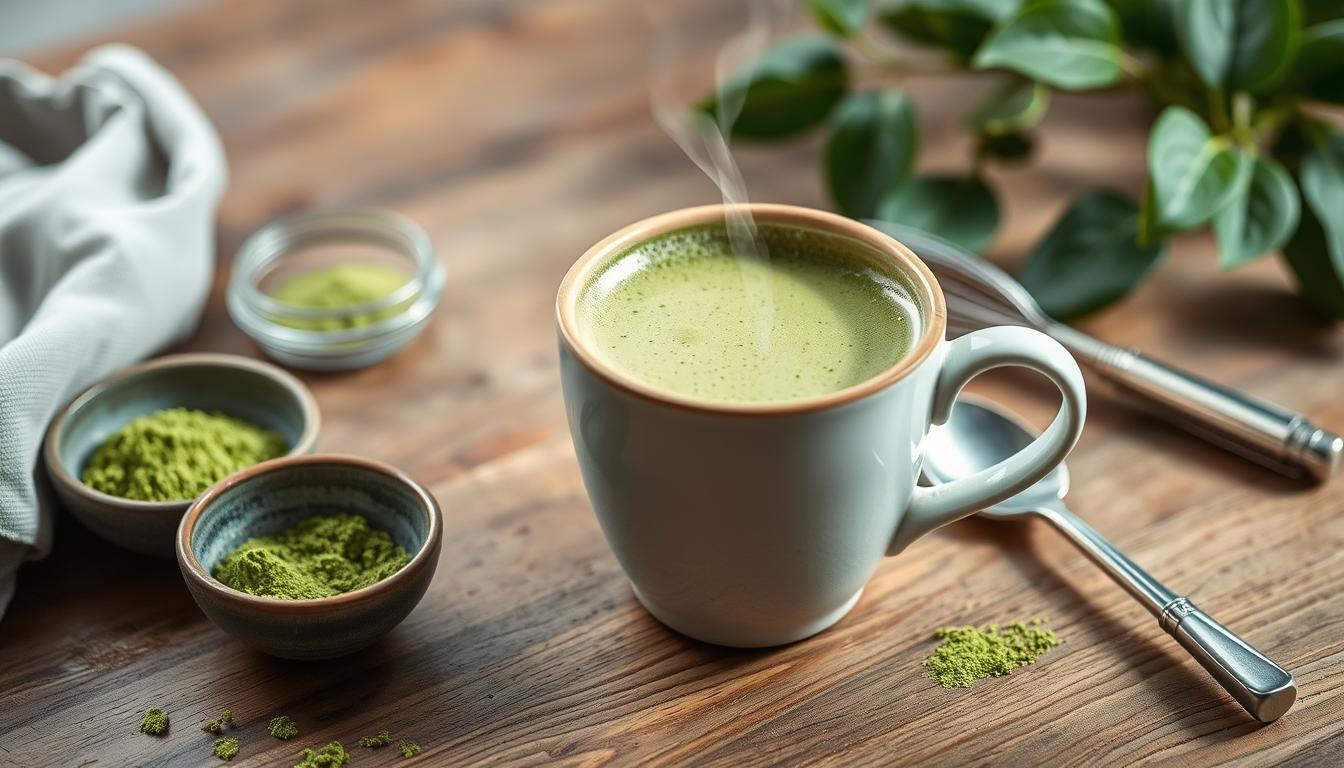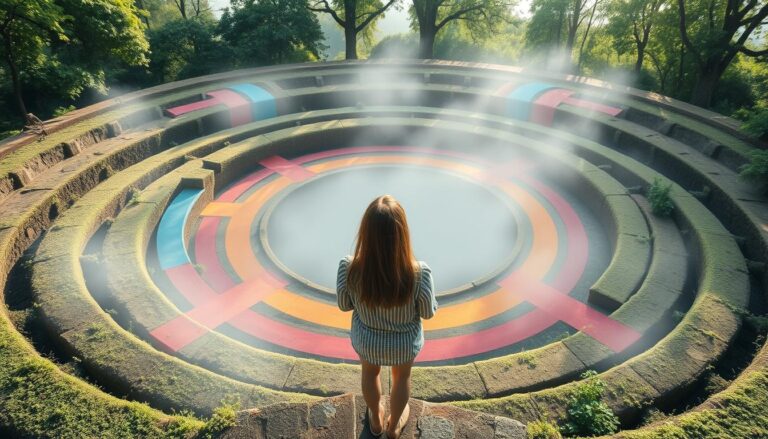Imagine yourself in a cozy Japanese tea house. The air is filled with the delicate aroma of freshly whisked Matcha tea. As we sip this vibrant green elixir, we’re transported to a world of tranquility and mindfulness. Today, we’re going to show you how to recreate this calming experience in your own home with a simple and delicious Matcha latte recipe.
Growing up, Matcha was a part of my family’s daily ritual. It was a moment of pause and reflection amidst the hustle and bustle of everyday life. The ritual of preparing and sipping this ceremonial green tea always held a sense of magic and wonder for me. Now, I’m excited to share this timeless tradition with you and help you unlock the secrets to crafting the perfect Matcha latte.
In this guide, we’ll explore the rich history and health benefits of Matcha. We’ll also cover the essential tools and techniques needed to elevate your homemade Matcha latte to new heights. Whether you’re a Matcha enthusiast or a newcomer to this vibrant tea, you’ll find everything you need to become a Matcha latte master in your own kitchen.
Understanding the Magic of Matcha Green Tea
Matcha tea is a favorite in Japan, known for its health benefits. It’s made from the best Camellia sinensis leaves. This green powder gives tea lovers a special experience.
Traditional Japanese Origins
Matcha’s history goes back to the 12th century. It was first used in Japan’s tea ceremony. This ceremony made tea a symbol of mindfulness and beauty.
Health Benefits and Antioxidant Properties
- Matcha is packed with antioxidants, more than regular green tea.
- Drinking matcha can boost brain function and metabolism. It also lowers the risk of chronic diseases.
- Matcha’s special processing means you get all the nutrients from the tea leaf.
Different Grades of Matcha Powder
Matcha quality varies a lot. The price and quality depend on where it’s grown, how it’s harvested, and how it’s processed. Ceremonial-grade matcha is the best for its taste and smell. Culinary-grade is better for cooking and baking.
Exploring matcha’s history, health benefits, and types shows its magic. Whether you love tea or are new to it, matcha will enchant you.
Essential Tools and Equipment for the Perfect Matcha Latte
Making a great matcha latte at home needs some key tools and equipment. We’re here to help you get the right stuff for making matcha. Let’s look at the important items that will make your Matcha Powder, Barista Skills, and Cafe Drinks better.
The Matcha Whisk: Your Secret to Smooth Blends
The bamboo whisk, or “chasen,” is central to making matcha. It’s made to whisk the Matcha Powder into a smooth, frothy mix. Its fine tines blend everything well, giving your matcha latte its signature foam.
Sifting for Perfection
Sifting the Matcha Powder is key for a silky latte. Use a fine-mesh sieve or matcha sifter to get rid of clumps. This makes sure your matcha blends well with milk.
Milk Frothing: The Barista's Touch
A creamy, frothy milk topping is essential for a matcha latte. A good milk frother, manual or electric, is needed for this. Learning to froth milk is a Barista Skill that makes your matcha lattes stand out.
| Essential Tool | Purpose |
|---|---|
| Bamboo Matcha Whisk (Chasen) | Blending Matcha Powder into a smooth, frothy consistency |
| Matcha Sifter or Fine-Mesh Sieve | Removing clumps and impurities from the Matcha Powder |
| Milk Frother (Manual or Electric) | Creating the perfect microfoam for a cafe-style Matcha Latte |
With these tools, you’ll be making Cafe Drinks-worthy matcha lattes at home. Become your own barista and let Matcha Powder’s magic show in your drinks.
Simple Ingredients for Your Homemade Matcha Latte Recipe
Making a tasty Matcha Latte at home is easy. You just need a few basic ingredients. Let’s explore the key parts to make a smooth, frothy, and tasty Matcha Latte in your kitchen.
Choosing Quality Matcha Powder
The base of a great Matcha Latte is the Matcha powder. Look for high-quality, ceremonial-grade Matcha. It should be bright green. This Matcha will give your latte a rich flavor and creamy texture.
Milk Options and Alternatives
Matcha Lattes can be made with dairy or plant-based milks. Try unsweetened almond milk, creamy oat milk, or coconut milk for a unique taste. Pick a milk that goes well with Matcha’s earthy taste.
Sweetener Recommendations
To balance Matcha’s bitterness, add a bit of sweetener. Use natural sweeteners like honey, maple syrup, or organic cane sugar. Start with a teaspoon and adjust to taste. Vanilla extract or cinnamon can also add to the flavor.
With these ingredients, you’re ready to make a delicious Matcha Latte at home. Try different Matcha powders, milks, and sweeteners to find your favorite. Enjoy the creamy, frothy goodness of a homemade Matcha Latte anytime.
The Art of Water Temperature and Measurements
Creating the perfect Matcha tea latte requires mastering water temperature and precise measurements. As Matcha lovers and barista skill enthusiasts, we know these factors are key. They make all the difference in making a great cafe-quality drink at home.
The ideal water temperature for making Matcha lattes is between 160°F to 180°F (71°C to 82°C). This range ensures the Matcha powder dissolves well, bringing out the best flavor and aroma. Water that’s too hot can make the tea taste bitter, while water that’s too cool can make it taste weak.
Getting the measurements right is also important. The usual ratio is 1 to 2 teaspoons of Matcha for every 6 ounces of water. You might need to adjust this based on your taste and the Matcha quality. Accurate measurements help achieve a balanced flavor and a smooth texture in your latte.
- Use a digital scale or precise measuring spoons to measure the Matcha powder.
- Invest in a reliable gooseneck kettle or electric water heater to precisely control the water temperature.
- Experiment with the Matcha-to-water ratio to find your personal sweet spot.
| Matcha Powder | Water Temperature | Outcome |
|---|---|---|
| 1-2 tsp | 160°F to 180°F | Optimal flavor extraction and texture |
| Less than 1 tsp | Below 160°F | Weak, watery latte |
| More than 2 tsp | Above 180°F | Bitter, astringent taste |
By mastering water temperature and measurements, you can make Matcha lattes as good as those in your favorite cafe. Unleash your barista skills and enjoy the perfect Matcha experience at home.
Step-by-Step Matcha Latte Recipe
Making a matcha latte at home is an art that needs focus and care. We’ll show you how to make it, from sifting the matcha to frothing the milk. Follow these steps, and you’ll make a Matcha Latte Recipe just like a cafe’s.
Sifting and Whisking Techniques
Start by sifting the matcha powder through a fine-mesh strainer. This step is key to avoid lumps. After sifting, whisk the matcha with a bit of hot water. Use a bamboo whisk or a milk frother in a zig-zag motion until it’s frothy.
Milk Frothing Methods
- To get the creamiest milk, use a milk frother or steam wand. Heat the milk gently until it’s warm, then froth it until it’s velvety.
- Or, you can froth the milk manually with a French press or whisk. Just whisk or pump the plunger until the milk is light and airy.
Assembly Instructions
- Pour the whisked matcha into your cup or glass.
- Pour the frothed milk over the matcha, making Latte Art on top.
- Add honey or maple syrup if you like it sweeter.
- Drink your homemade Matcha Latte Recipe right away, enjoying its flavor and creaminess.
With these steps, you can make a Matcha Latte Recipe like a pro at home. Try different milks and sweeteners to find your favorite. Enjoy the green color, frothy texture, and rich taste of this amazing drink.
Common Mistakes to Avoid When Making Matcha Lattes
Making a Matcha Tea latte at home can be fun, but mistakes happen. We’ve found common errors that people make. By avoiding these, you can make delicious Matcha Lattes that everyone will love.
One big mistake is using water that’s too hot. Matcha needs water around 175-185°F to taste right. Water that’s too hot makes it bitter, while cooler water doesn’t bring out the best flavors.
Another mistake is not whisking the Matcha right. It should be smooth and frothy. Use a bamboo whisk or an electric frother to whisk it well. This makes the Matcha layer on top perfect.
- Using the wrong water temperature
- Improper whisking technique
- Overmixing or undermixing the ingredients
- Choosing a low-quality Matcha powder
- Forgetting to sift the Matcha before use
Some people also mix the Matcha, milk, and sweetener too much or too little. The goal is to mix it just right. With practice, you’ll get it right and make amazing Matcha Lattes.
| Common Mistakes | Solutions |
|---|---|
| Using the wrong water temperature | Brew with water that’s 175-185°F |
| Improper whisking technique | Use a bamboo whisk or electric frother and whisk in a zig-zag motion |
| Overmixing or undermixing the ingredients | Gently stir to incorporate all components without creating too much foam |
| Choosing a low-quality Matcha powder | Invest in a premium, culinary-grade Matcha for the best flavor and aroma |
| Forgetting to sift the Matcha before use | Sift the Matcha powder through a fine-mesh strainer to prevent clumps |
Creating Beautiful Matcha Latte Art
Matcha lattes are more than just a drink. They can be a work of art. Learning latte art can turn your drinks into stunning creations. We’re here to teach you how to make matcha latte designs that will wow everyone.
Basic Pouring Techniques
Latte art starts with the right pouring technique. First, froth your milk until it’s smooth and creamy. Then, pour it slowly and steadily into your cup. Try different pouring speeds and angles to make cool designs.
Design Patterns for Beginners
Latte art is easier than it looks. Start with simple shapes like hearts or tulips. Pour the milk carefully to create these designs. As you get better, you can try more complex patterns.
Creating beautiful latte art takes patience and practice. But with time, you’ll make drinks that look amazing. So, get creative and make your matcha lattes truly special.
Hot vs. Iced Matcha Latte Variations
Do you like a warm drink or a cool treat? We’ve got you covered with our guide to hot and iced matcha latte recipes. Matcha, the vibrant green powdered tea, is great in both hot and cold drinks. It offers a mix of earthy, sweet, and antioxidant-rich flavors.
For a classic hot matcha latte, use freshly boiled water. Whisk the matcha powder until it froths into a smooth, creamy drink. Add your favorite milk, like dairy or plant-based, and enjoy the cozy warmth. You can also add a bit of honey or maple syrup for sweetness.
On hot summer days, an iced matcha latte is a refreshing choice. Brew a strong matcha tea, then pour it over ice cubes. Dilute it with your preferred milk. The cold temperature brings out the natural sweetness of the matcha, making it refreshing and invigorating. Try different milks, like almond, oat, or coconut, to find your favorite iced matcha latte.
FAQ
What is a matcha latte, and how is it different from a regular green tea latte?
A matcha latte is a creamy drink made with matcha green tea powder and milk. It’s different from a green tea latte, which uses brewed leaves. Matcha lattes are more concentrated and have a richer taste.
What are the health benefits of matcha green tea?
Matcha is full of antioxidants, vitamins, and minerals. It boosts metabolism, improves focus, and supports health. Its unique processing keeps more of the tea’s good stuff than regular green tea.
What equipment do I need to make a matcha latte at home?
To make a matcha latte, you need a matcha whisk, a sifter, and a milk frother. These tools help you get the right texture and taste for your latte.
What type of matcha powder should I use for the best results?
Choose ceremonial-grade matcha for the best latte. It’s vibrant, smooth, and packed with nutrients. Culinary-grade matcha can taste bitter or grassy.
What’s the ideal water temperature for making a matcha latte?
The ideal water temperature is 175-185°F (79-85°C). Boiling water can burn the matcha, making it taste bad. The right temperature brings out the best flavor.
How do I achieve the perfect frothy texture for my matcha latte?
Whisking is key for a creamy latte. Use a bamboo whisk to mix matcha and hot water until it’s smooth. For extra creaminess, froth the milk first.
Can I make an iced matcha latte, or is it only meant to be served hot?
Yes, you can enjoy a matcha latte hot or iced. An iced version is refreshing for warm days. Just whisk the matcha, pour it over ice, and add milk.
What are some common mistakes to avoid when making a matcha latte?
Avoid using too hot water, not sifting the matcha, over-whisking, and getting the milk wrong. Pay attention to temperature, measurement, and technique for a perfect latte.
Can I create latte art designs with a matcha latte?
Yes! Matcha lattes are great for latte art. With practice, you can make designs like hearts and leaves. It’s a fun way to enhance your matcha lattes.















